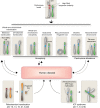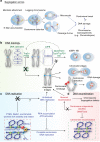The dark side of centromeres: types, causes and consequences of structural abnormalities implicating centromeric DNA
- PMID: 30337534
- PMCID: PMC6194107
- DOI: 10.1038/s41467-018-06545-y
The dark side of centromeres: types, causes and consequences of structural abnormalities implicating centromeric DNA
Abstract
Centromeres are the chromosomal domains required to ensure faithful transmission of the genome during cell division. They have a central role in preventing aneuploidy, by orchestrating the assembly of several components required for chromosome separation. However, centromeres also adopt a complex structure that makes them susceptible to being sites of chromosome rearrangements. Therefore, preservation of centromere integrity is a difficult, but important task for the cell. In this review, we discuss how centromeres could potentially be a source of genome instability and how centromere aberrations and rearrangements are linked with human diseases such as cancer.
Conflict of interest statement
The authors declare no competing interests.
Figures




Similar articles
-
Centromere formation: from epigenetics to self-assembly.Trends Cell Biol. 2006 Feb;16(2):70-8. doi: 10.1016/j.tcb.2005.12.008. Epub 2006 Jan 18. Trends Cell Biol. 2006. PMID: 16412639 Review.
-
Centromeres in cancer: Unraveling the link between chromosomal instability and tumorigenesis.Med Oncol. 2024 Oct 1;41(11):254. doi: 10.1007/s12032-024-02524-0. Med Oncol. 2024. PMID: 39352464 Review.
-
Repetitive Fragile Sites: Centromere Satellite DNA As a Source of Genome Instability in Human Diseases.Genes (Basel). 2018 Dec 7;9(12):615. doi: 10.3390/genes9120615. Genes (Basel). 2018. PMID: 30544645 Free PMC article. Review.
-
Emerging roles of DNA repair factors in the stability of centromeres.Semin Cell Dev Biol. 2024 Mar 15;156:121-129. doi: 10.1016/j.semcdb.2023.10.001. Epub 2023 Oct 16. Semin Cell Dev Biol. 2024. PMID: 37852903 Review.
-
Cellular Dynamics and Genomic Identity of Centromeres in Cereal Blast Fungus.mBio. 2019 Jul 30;10(4):e01581-19. doi: 10.1128/mBio.01581-19. mBio. 2019. PMID: 31363034 Free PMC article.
Cited by
-
A TRilogy of ATR's Non-Canonical Roles Throughout the Cell Cycle and Its Relation to Cancer.Cancers (Basel). 2024 Oct 19;16(20):3536. doi: 10.3390/cancers16203536. Cancers (Basel). 2024. PMID: 39456630 Free PMC article. Review.
-
Gross Chromosomal Rearrangement at Centromeres.Biomolecules. 2023 Dec 24;14(1):28. doi: 10.3390/biom14010028. Biomolecules. 2023. PMID: 38254628 Free PMC article. Review.
-
Spatial inter-centromeric interactions facilitated the emergence of evolutionary new centromeres.Elife. 2020 May 29;9:e58556. doi: 10.7554/eLife.58556. Elife. 2020. PMID: 32469306 Free PMC article.
-
The Sound of Silence: How Silenced Chromatin Orchestrates the Repair of Double-Strand Breaks.Genes (Basel). 2021 Sep 15;12(9):1415. doi: 10.3390/genes12091415. Genes (Basel). 2021. PMID: 34573397 Free PMC article. Review.
-
Epigenetic dynamics of centromeres and neocentromeres in Cryptococcus deuterogattii.PLoS Genet. 2021 Aug 31;17(8):e1009743. doi: 10.1371/journal.pgen.1009743. eCollection 2021 Aug. PLoS Genet. 2021. PMID: 34464380 Free PMC article.
References
Publication types
MeSH terms
Substances
LinkOut - more resources
Full Text Sources
Other Literature Sources

